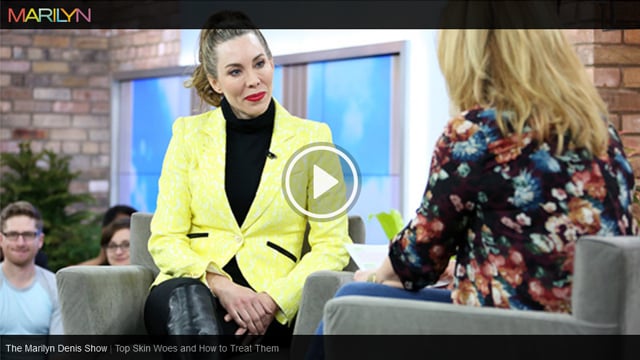The Marilyn Denis Show - Top Skin Woes and How to Treat Them: February 3, 2016
- Home
- Blog
- Current Media
- The Marilyn Denis Show - Top Skin Woes and How to Treat Them: February 3, 2016
Dermatologist Dr. Lisa Kellett talks common cosmetic complaints and how to treat them.
Excess fat under the chin
The area under the chin, sometimes referred to as a “double chin,” is a common yet undertreated facial concern for many adults. This excess fat affects both women and men and is influenced by several factors such as aging, genetics and weight gain. Furthermore, this condition is often resistant to diet and exercise.
Treatment:
Until recently, only surgical options for treatment were available, but a new non-surgical treatment is now available. BELKYRA™ is a new Health Canada-approved injectable treatment that can reduce “double chin” fat and contour the chin area. It is injected directly into the area and its naturally-occurring molecules help to breakdown fat. This treatment is done by specialist physicians.
- Prevention: No prevention
- Cost: Starting at $500
Facial Asymmetry
Facial asymmetry is a common condition affecting almost all people in varying degrees of severity. Like other parts of the body, the face can be unbalanced. Humans are conditioned to compensate for facial asymmetry but many people are very self-conscious and concerned about it.
Treatment:
Historically, surgery was often required to correct this but we are now using Hyaluronic acid (HA)-based substances in children and adults to help correct symmetry in the chin, jawline and cheeks. It can also be used at sites of trauma from car accidents to fill in depressions. HA injectables are derived from naturally-occurring sugars similar to those in the body and they can create volume and lift. HA can be injected into the skin in areas of asymmetry to help correct any areas of lesser volume or contour.
- Prevention: No prevention
- Cost: Starting at $500
Scars
Scars result from the attempt of the body to repair itself after injury such as accidents, cuts and surgery. Scars are a natural healing process but some scars may take longer to heal based on the extent of damage to the skin. The longer a scar takes to heal, the greater the chance of a noticeable scar. The way a scar forms is affected by an individual's age, body site, overall health, depth of the scar among other factors.
Treatment
The newest method to treat scars is to use multiple modalities in the same treatment session. This includes a superficial testament to prep the skin, a light treatment and a resurfacing treatment at the same time. This technique can flatten scars, reduce redness and improve texture.
- Prevention: No prevention
- Cost: Starting at $350
Stretch Marks
Stretch marks occur due to pregnancy, weight gain or a growth spurt when the skin stretches too quickly. Stretch marks are most commonly red or purple initially and turn silvery-white with time.
Treatment:
Each kind of stretch mark is treated differently. Red or purple stretch marks are in the early-stage of scarring and are usually treated with a vascular laser which removes the redness. Silver stretch marks can be treated using a fractionated resurfacing laser such as ProFractional. There are no creams that permanently get rid of stretch marks, retinol liquids can also be helpful.
- Prevention: No prevention
- Cost: Starting at $350



